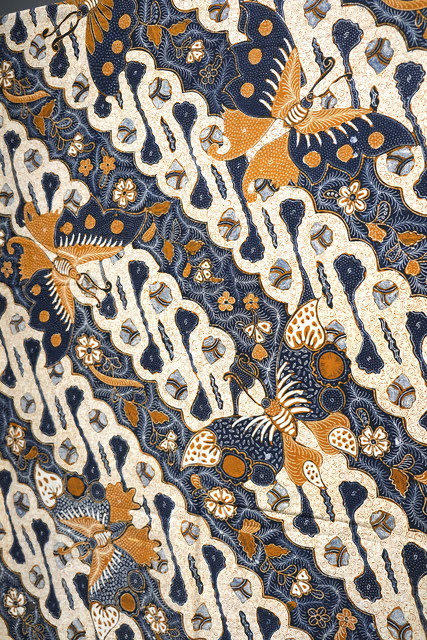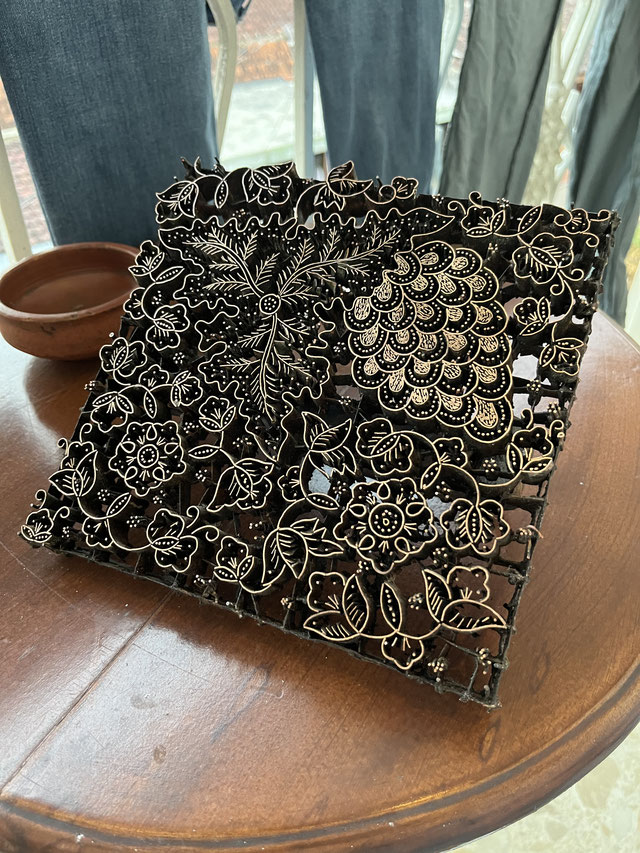
In October of 2023 I went on holiday to Indonesia and there in Yogjakarta, in what is commonly considered the artisan and crafts capital of the nation, I studied the art of batik. Batik is an
ancient tradition in Indonesia, created by blocking out parts of a cloth with wax to dye over the unblocked parts and craft intricate patterns. The wax in batik can be applied by hand with a
so-called canting tool, or applied with a stamp dipped in hot wax. To make multi-coloured patterns, new layers of wax have to be laboriously re-applied in between the various dye steps. It is a
time-consuming art which requires a steady hand and experience. In 2009, batik was added to the UNESCO list of immaterial cultural treasures. Batik has been practiced as an art form around the
world - we know it was produced in ancient Egypt - but Indonesia has shaped it into a particular tradition. It is reckoned that batik was introduced to the island of Java in what is in Europe the
early middle ages (probably around the 7th century). Then, a Hindu-Buddhist period marked Indonesia culturally. Due to the tropical climate, textiles do not survive very long generally, limiting
the amount of antique batik textiles available. The oldest surviving object was probably manufactured in the 14th century.
Batik motives are connotated with different occasions, such as special wedding patterns. In 1940, the sultan of Yogjakarta removed the remaining sumptuary laws that restricted the use of batik
patterns to make all designs accessible to all of society.
Yogjakarta lies in the middle of the main island of Java, at the south coast. Surrounded by rainforest and two of Indonesia‘s most famous temples, the city is brimming with culture and museums.
The batik museum is well worth visiting to see an astonishing variety of patterns - from 18th century floral designs to modern rock guitars.
I booked a batik introduction course online and on the day took a taxi to the suburbs of Yogjakarta. There, I was given the choice of pieces of cotton cloth which my teacher very
kindly had pre-drawn designs on. I could have drawn my own design but decided to go along with a traditional Indonesian pattern. The cloth was then strung to a wooden frame. Next, I was to
familisarise myself with handling the canting tool. It is essentially the shape of a tiny car oil canister with a vessel and long snout made from copper and attached to a wooden stick. You have
to dip it into the wax cauldron, swiftly let extra wax drip off and then move on to drawing before it cools enough to slow the flow of the wax. On the cloth, you have to move at a steady pace to
create a line - neither getting caught in the cotton surface unevennesses and producing a wax spill but also not moving too fast or the wax won‘t penetrate the fabric enough to block out the dye.
Once all wax is applied to form the pattern (these parts would stay white due to it blocking out the white cotton underneath), I got to hand-colour in the pattern. Once dried, my teacher boiled
the cloth to remove the wax. This shrunk the fabric by around 10% which artists have to account for. Finally, I got to wait for the cloth to dry in the sun while snacking on local
delicacies.

Batik stamps are made from soldering metal strips bent into shape onto a metal handle.



